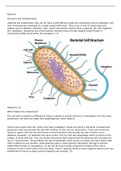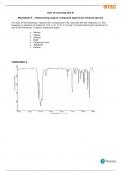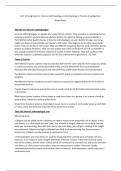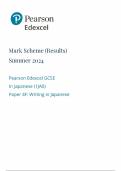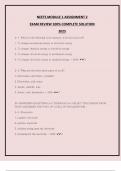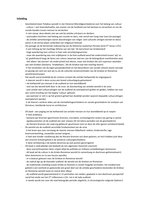Bacteria
Structure and characteristics
-bacteria are prokaryotes, they do not have a well-defined nuclei and membrane bound organelles, and
with chromosomes composed of a single closed DNA circle. They come in lots of varied sizes and
shapes such at spheres, cylinders, rods, chains and spirals. Bactria have a capsule, cell wall, flagellum,
pili, cytoplasm, ribosomes and chromosomes. Bacteria has a circular shaped single thread of
chromosome DNA found within the cytoplasm. (1)
Diagrams (2)
What makes this a bacterium?
The cell wall in bacteria is different to those in plants or animal cells as its composition isn’t the same,
prokaryotic cell walls are made from peptidoglycan which helps to
protect and support the cell. Some may have a flagellum, these are found in bacterial, archaeal and
eukaryotic cells and provide the cell with mobility, so the cell can move/swim. These are commonly
found on sperm cells but are also found on some bacterial cells as they can also function as an
adhesive organelle. (3) bacteria may have a pilus; this is a hair like appendage which is found on the
surface of some bacteria. They are protein structures that extend from the bacteria cell’s envelope for
up to 2 micrometres. The pili allows the cell to essentially crawl across a surface, and they allow other
cells to adhere to one another, while allowing cells to share genetic information through a process
called DNA transfer or conjugation. (4) pili can be found evenly around the surface of the cell or
localised at one or both ends of the two poles, they’re typically found on gran negative bacteria but can
sometimes be found on gram positive bacteria and archaea. (5)
,Ways of classifying
Bacteria can be classified into 5 groups depending on their basic shape and size, these include a
spherical cocci shape (0.2-1.0 micrometres), rod bacilli (1.0-5.0micrometres), spiral spirilla (2-100
micrometres), comma vibrio (2-3 micrometres) and corkscrew spirochaetes(20micrometres). They Can
either exist as single cells, in pairs or in chains or clusters.
It can also be classified based on its cell structure, cellular metabolism, or in differences in cell
components such as its DNA, fatty acids, pigments, and antigens. (6) Their optimal growth
temperature can also be a way of classifying bacteria.
It can be classified by the way it reproduces; most bacteria will reproduce by binary fission which is an
asexual process where a singular cell divides into two.
-Bergey’s manual systematic bacteriology is the main resource for identifying bacterial species. It was
published in 1923 and it classifies bacteria into species, families, and orders based on their functional
and structural characteristics, for example a mosquito will be in the animalia kingdom, Arthropoda
phylum, insecta class, Diptera order, Culicidae family, aedes genus, and the titchii species. (7)
-gram staining classifies bacteria according to their cell wall constituents; the gram stain procedure
distinguishes between gram negative and gram-positive cells by colouring them as red or violet. As a
gram-positive bacteria will have a thicker peptidoglycan layer, they will retain the crystal violet stain
during the decolourisation process. (7) (2a)
,diagram of the cell walls (9),
- The gram staining procedure is based on the reaction between peptidoglycan in the cell walls of the
bacteria. The Gram stain involves staining the bacteria, and fixing the colour with a mordant, which
decolourises the cells, and then applying a counterstain.
The primary stain crystal violet would then bind to peptidoglycan, colouring cells purple. Both gram-
positive and gram-negative cells have peptidoglycan in their cell walls, so at first all bacteria will be
stained violet.
Gram's iodine (iodine and potassium iodide) would then be applied as a mordant or fixative. The Gram-
positive cells will form a crystal violet-iodine complex.
Now Alcohol or acetone would be used to decolorize the cells. Gram-negative bacteria will have much
less peptidoglycan in their cell walls, so this step will essentially leave them colourless, however only
some of the colour is removed from gram-positive cells, which have more peptidoglycan that could
compose up to 60-90% of the cell wall. The cell wall of gram-positive cells is then dehydrated by the
decolorizing step, which causes them to shrink and trapping the iodine stain inside.
After the decolorizing step has taken place, a counterstain should be applied which is usually safranin,
but sometimes fuchsine to colour the bacteria pink. gram-positive and gram-negative bacteria would
be able to pick up the pink stain, however you are unable to see the pink stain over the darker purple
of the gram-positive bacteria. If the staining procedure is performed correctly, gram-positive bacteria
will be purple, while gram-negative bacteria will be pink. (10)
The results of the Gram stain can be viewed using a light microscope. Because the bacteria are
coloured, their Gram stain group found, as well as their shape, size, and clumping pattern of some kind
may be seen. This makes the Gram stain an incredibly valuable diagnostic tool for a medical clinic or
lab. While the stain may not be 100% correct, often knowing whether they are gram-positive or gram-
negative is sufficient for prescribing an effective antibiotic. (10)
Bacteria do not have any membrane -bound organelles, however they are able to and can function and
reproduce as individual cells, therefore they're able to reproduce asexually which means they do not
, need to have another organism to reproduce; they can reproduce on their own via binary fission, but
they do often group together in multicellular colonies. Their genome is usually a single loop of DNA,
although they can also hold small pieces of DNA which are called plasmids. These plasmids can be
transferred between cells through a process called bacterial conjugation. a cell wall surrounds bacteria
and supplies strength and rigidity to their cells.
bacteria can be classified by whether it respires aerobically or anaerobically. Obligate anaerobes can
only exist without oxygen because it poisons them and kills them.
most types of bacteria will respire anaerobically. Which basically means, they can go through the
process of respiration without any oxygen present. However, instead of using oxygen to help them use
up their energy, these types of bacteria use other naturally occurring chemicals to create chemical
reactions and release the energy they need. Common naturally occurring chemicals used include
chemicals such as nitrates, sulphates and carbon dioxide. Anaerobic respiration in bacteria generally
creates many by-products. Lots of these by-products can be toxic or dangerous to humans and include
ethanol and hydrogen.
On the other hand, some bacteria do respire aerobically. Aerobically respiring bacteria will require
oxygen to live. They use oxygen as fuel to help burn energy and provide them with the energy needed
for continuing their life. This type of bacterial respiration is the similar/the same kind that us humans
will end up using, which is why it has the term "aerobic exercise." The major by-product of aerobic
respiration from bacteria is carbon dioxide. (11)
Binary fission Step 1- Replication of DNA
The bacterium uncoils and replicates its chromosome, essentially doubling its content.
Step 2- Growth of a Cell
After copying the chromosome, the bacterium starts to grow larger in preparation for binary fissions. It
is followed by an increase in cytoplasmic content. Another prominent trait of this stage is that the two
strands migrate to opposite poles of the cell.
Step 3-Segregation of DNA
The cell elongates with a septum forming at the middle. The two chromosomes are also separated in
this phase.
Step 4- Splitting of Cells
A new cell wall is formed at this phase, and the cell splits at the centre, dividing the parent cell into
two new daughter cells. Each of the daughter cells contains a copy of the nuclear materials as
necessary organelles.
Fungus
Structure and characteristics (12c)

